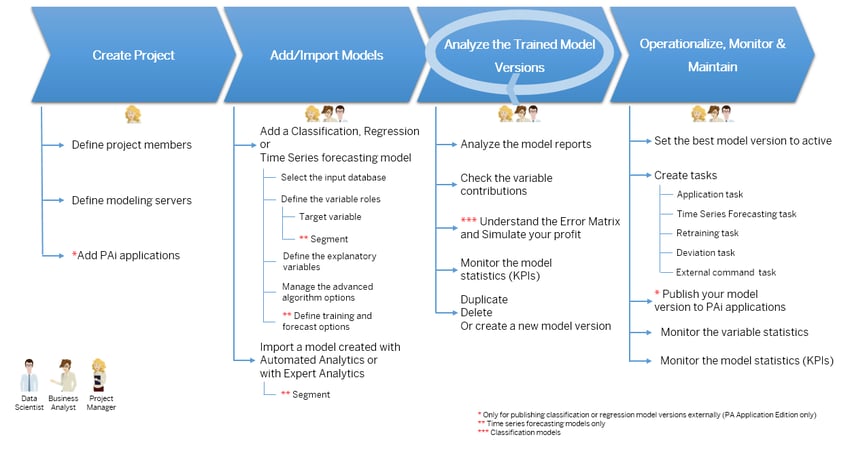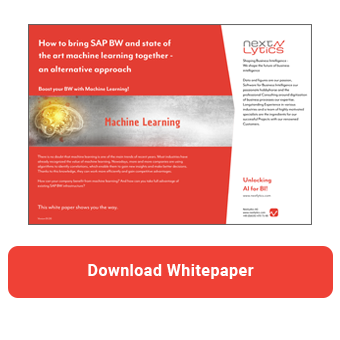SAP Predictive Analytics enables companies to forecast future events and make data-driven, informed decisions. Various statistical and analytical techniques are used to sift through vast amounts of data for hidden patterns and relationships. Predictions can be made regarding customer behavior, product demand, sales and profits and much more.
SAP Predictive Analytics covers eight functional areas: automated analysis, expert analysis, model management, data management, predictive scoring, social media analytics, product recommendations and visualization. With its easy-to-use interface, machine learning workflows can be created without any coding using drag & drop.
SAP Predictive Analytics includes several tools, such as Automated Analytics, Expert Analytics, and Predictive Factory. While Automated Analytics offers a low entry hurdle for business users, Expert Analytics is aimed at professional data analysts and data scientists. Predictive Factory simplifies and automates the forecast model lifecycle.
Classification of Predictive Analytics
SAP Predictive Analytics combines the former SAP Infinite Insight and SAP Predictive Analysis products into a single data analysis product. Automated Analytics, formerly marketed as Infinite Insight, was developed by KXEN and acquired by SAP in 2013. Expert Analytics, in contrast, was marketed as SAP Predictive Analysis until a few years ago. With Predictive Analytics, SAP is trying to make the transition smooth for people who previously used either SAP Infinite Insight or SAP Predictive Analysis, and provides all functions of the two independent products.
SAP Predictive Analytics can be deployed as a standalone on-premise software or as a cloud solution. Through integration with SAP Cloud Platform, you can benefit from freely scalable capacities for big data and machine learning. You can also use SAP Vora to leverage large amounts of data from Hadoop.
Detailed presentation of the functions
As mentioned above, SAP Predictive Analytics actually includes three different toolsets: Automated Analytics for business users, Expert Analytics for data scientists and Predictive Factory to automate the management of models. Automated Analytics contains easy-to-use and highly automated functions for performing data analysis and forecasting. Automated Analytics also helps prepare data for analysis. Expert Analytics takes a somewhat more general approach and includes various models that can be used in a custom analysis, as well as data mining tools. Predictive Factory allows you to manage a complete forecast lifecycle: from project creation to model generation and rebuilding, model evaluation, implementation, monitoring and versioning.
In the following we will present the individual components in detail.

Automated Analytics
Automated Analytics includes automated data preparation, predictive modeling and a scoring solution for users who have no formal background in data science or data analytics. The tool enables users to implement advanced analysis models that include classification, regression, segmentation, time series, social network analysis and product recommendation.
Automated Analytics supports the user by providing automated processes for data preparation, modeling and deployment. On the one hand, this increases data quality by eliminating the errors that are introduced via manual procedures. On the other hand, users also need to execute fewer process steps.
The following modules are delivered with Automated Analytics:
- Data Manager simplifies the preparation of the data required for the analysis project.
- Modeler allows business users to create models for classification, regression, clustering, time series and association rules. Models from the development environment can be exported and used in production.
- Social extracts and uses data from social networks to improve the models' decision-making and forecasting capabilities. Diagrams can be used to show connections between the different data. You can also create collocation analyses using geo-referenced data.
- Recommendation generates product recommendations for your customers. The analysis provided by Social serves as the basis.
Expert Analytics
In contrast to Automated Analytics, Expert Analytics is aimed at professional data scientists and data analysts. It includes various algorithms for data analysis, such as time series prediction, outlier detection, trend analysis, segmentation analysis and affinity analysis. Furthermore, the R programming language is also supported in order to use own algorithms. In addition, you can visualize the data using scatter matrix plots, parallel coordinates, cluster plots and decision trees. Expert Analytics also includes in-memory data mining functions that allow you to analyze large amounts of data.
Expert Analytics allows you to use different data sources, such as flat files, relational databases and in-memory databases. This allows you to handle different data volumes, from small CSV files to large volumes of data from SAP HANA.
Expert Analytics includes the following components:
- Data Visualization allows you to perform in-depth data analysis using various visualization techniques, such as scatter matrix diagrams, parallel coordinates and decision structures.
- With Data Analysis, you can perform a variety of different data analyses and create models to perform time series forecasts, outlier detection, trend, classification, segmentation and affinity analyses.
- Data Analytics provides a range of algorithms for analytical forecasting and in-memory data mining capabilities. In addition, the R language is also supported for your own algorithms.
Predictive Factory
With Predictive Factory, you can automate the management of forecast models created with SAP Predictive Analytics. It covers the complete forecast lifecycle, from project creation to model creation and rebuilding, model evaluation, implementation, monitoring and versioning.
With Predictive Factory you can:
- Create and train classification, regression and time series forecasting models
- Import existing models created in Automated Analytics or Expert Analytics
- Import, train and apply predictive model pipelines
- Automate tasks for retraining and reapplying models, testing model deviation, making predictions, and executing external commands
- Segment time series models. This allows you to apply the same forecast mechanism to different segments of the data set simultaneously.
- Monitor the performance of your models over time and identify deviations
- Transfer classification or regression model versions to an external application

In summary, the combination of automated analysis and expert analysis provides tools for both business users and professional data analysts. The entire life cycle of the analysis is covered. In the next section we will go into the advantages and disadvantages of the tool in detail.
How to bring SAP BW and state of the art machine learning together
Advantages and disadvantages
There is no doubt that SAP Predictive Analytics has a raison d'être based on its historical development. Its advantages include easy connection to data sources and a user-friendly interface. The tool has a modern, intuitive user interface, which allows easy handling. Models can be created by drag & drop without any programming knowledge. Automated Analytics supports the user in data analysis without the need to select the model and fine-tune the parameters.
In addition, integrated functions for data preprocessing and visualization in Lumira style are offered. Customer-specific R code can also be integrated via an R-interface. Hadoop integration via SAP VORA also makes working with Big Data much easier.

A disadvantage is the limited number of machine learning algorithms provided. Especially more complex tree-based procedures and deep learning algorithms are not supported. Also in the area of time series analysis, experienced users have only a limited scope, since the primary focus is on statistical models such as exponential smoothing.
Furthermore, many of the state-of-the-art algorithms, are not implemented. High innovative power in the area of developing new, promising algorithms cannot be used because these are not integrated. Due to the exclusive use of the methods and functions offered, flexibility is limited.
Although it is possible to integrate own algorithms via R, this language has less acceptance by the data science community. The programming language Python is more widely used, but is not yet integrated. Thus, the tool has only limited capabilities and additionally requires the Predictive Factory to enable productive operation.
Please note that the client-based solution uses the underlying hardware of the client for the calculations. The lack of GPU support also increases the training time of models. Finally, increasing costs due to licenses have to be considered.
As you can see, SAP Predictive Analytics has both advantages and disadvantages. But what does SAP's future product strategy look like?
SAP product strategy
SAP is increasingly focusing on cloud products such as SAP Analytics Cloud and SAP Cloud Platform, which also have their own predictive capabilities. Therefore, SAP Predictive Analytics is no longer being developed.
According to SAP's Product Availability Matrix (PAM), the maintenance of SAP Predictive Analytics will end on December 31, 2022. Therefore, from our point of view, the new entry into SAP Predictive Analytics is no longer worthwhile. SAP Data Intelligence is positioned as the successor, but the tool is not yet technically mature.
Our Summary - Machine Learning with SAP Predictive Analytics
Due to the numerous drawbacks, SAP Predictive Analytics is not the perfect solution. Particularly serious is the limited number of algorithms, which are also not state-of-the-art. R is used as the programming language for customer-specific algorithms, although it has a much smaller community than Python. Python has a much larger community and an established data science ecosystem, but is not supported by predictive analytics. Finally, the product is also to be assessed negatively in terms of sustainability, since it will soon run out of maintenance. The future is uncertain as the successor is still immature. Therefore, SAP Predictive Analytics cannot be recommended.
If you want to know how to transform your data into insights that can drive customer engagement and sales, improve operational performance, and reduce risk across the enterprise, our whitepaper "SAP BW and State of the Art Machine Learning" is for you. In this paper, we'll show you how to effectively manage a machine learning project to solve your business problems faster, better and cheaper.

/Logo%202023%20final%20dunkelgrau.png?width=221&height=97&name=Logo%202023%20final%20dunkelgrau.png)
























